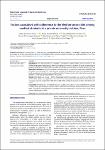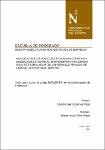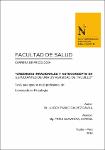Mostrar el registro sencillo del ítem
Factors associated with adherence to the Mediterranean diet among medical students at a private university in Lima, Peru
| dc.contributor.author | Vera Ponce, Victor Juan | |
| dc.contributor.author | Guerra Valencia, Jame | |
| dc.contributor.author | Torres Malca, Jenny Raquel | |
| dc.contributor.author | Zuzunaga Montoya, Fiorella E. | |
| dc.contributor.author | Zeñas Trujillo, Gianella Zulema | |
| dc.contributor.author | Cruz Ausejo, Liliana | |
| dc.contributor.author | Loayza Castro, Joan A. | |
| dc.contributor.author | De La Cruz Vargas, Jhony A. | |
| dc.date.accessioned | 2023-10-18T23:44:37Z | |
| dc.date.available | 2023-10-18T23:44:37Z | |
| dc.date.issued | 2023-03-15 | |
| dc.identifier.citation | Vera, V. J., Guerra, J., Torres, J. R., Zuzunaga, F. E., Zeñas, G. Z., Cruz, L., Loayza, J. A., & De La Cruz, J. A. (2023). Factors associated with adherence to the Mediterranean diet among medical students at a private university in Lima, Peru. Electronic Journal of General Medicine, 20(4), 483. https://doi.org/10.29333/ejgm/13083 | es_PE |
| dc.identifier.other | . | es_PE |
| dc.identifier.uri | https://hdl.handle.net/11537/34626 | |
| dc.description.abstract | Introduction: The Mediterranean diet (MedD)is a characteristic eating pattern of the countries of the Mediterranean region. Nonetheless, is unknown its adherence in medical students. We aimed to determine the prevalence of adherence to the Mediterranean diet (AMedD) and associated factors in medical students from Peru. Material and methods: Analytical cross-sectional study carried out by means of a virtual survey. PREDIMED scale was used to evaluate AMedD. The factors assessed were age, sex, academic year, body mass index (BMI), place of lunch consumption, cigarette smoking, and physical activity. Poisson regression with robust variance was used to present it in crude and adjusted prevalence ratios (PRa). Results: High AMedD was present in 38.50%. Statistically significant association was found for sex (PRa: 0.623; 95%CI 0.488-0.796); for overweight (PRa: 0.417; 95%CI 0.270-0.644), obesity (PRa: 0.591; 95%CI 0.400-0.874) versus normopese; cigarette smoking (PRa: 0.450; 95%CI 0.263-0.773); and high physical activity (PRa: 1.652; 95%CI 1.233- 2.215). Conclusions: AMedD was low. The related factors were sex, BMI, consumption of lunch outside the home, cigarette smoking, anda high level of physical activity. Ifthis is confirmed in future studies, it would be necessary to consider these elements to encourage greater consumption of MedD components by students, which would help to improve their long-term health. | es_PE |
| dc.format | application/pdf | es_PE |
| dc.language.iso | spa | es_PE |
| dc.publisher | Modestum LTD | es_PE |
| dc.rights | info:eu-repo/semantics/openAccess | es_PE |
| dc.rights | Atribución-NoComercial-CompartirIgual 3.0 Estados Unidos de América | * |
| dc.rights.uri | https://creativecommons.org/licenses/by-nc-sa/3.0/us/ | * |
| dc.source | Universidad Privada del Norte | es_PE |
| dc.source | Repositorio Institucional - UPN | es_PE |
| dc.subject | Dieta | es_PE |
| dc.subject | Factores epidemiológicos | es_PE |
| dc.subject | Índice de masa corporal | es_PE |
| dc.title | Factors associated with adherence to the Mediterranean diet among medical students at a private university in Lima, Peru | es_PE |
| dc.type | info:eu-repo/semantics/article | es_PE |
| dc.publisher.country | PE | es_PE |
| dc.identifier.journal | Electronic Journal of General Medicine | es_PE |
| dc.subject.ocde | https://purl.org/pe-repo/ocde/ford#3.03.04 | es_PE |
| dc.description.sede | San Juan de Lurigancho | es_PE |
| dc.identifier.doi | https://doi.org/10.29333/ejgm/13083 |







